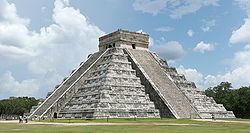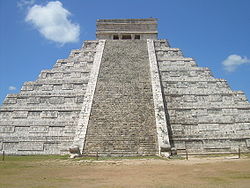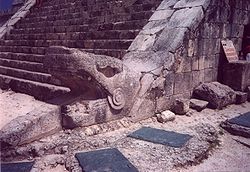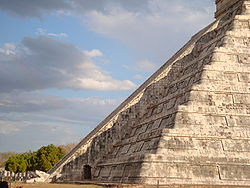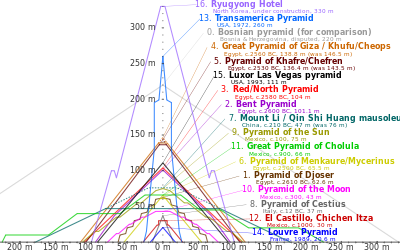- El Castillo, Chichen Itza
-
El Castillo (Spanish for "castle"), also known as the Temple of Kukulkan, is a Mesoamerican step-pyramid that dominates the center of the Chichen Itza archaeological site in the Mexican state of Yucatán. The building is more formally designated by archaeologists as Chichen Itza Structure 5B18.
Built by the pre-Columbian Maya sometime between the 9th and 12th centuries AD, El Castillo served as a temple to the god Kukulkan, the Yucatec Maya Feathered Serpent deity closely related to the deity figure Quetzalcoatl known to the Aztecs and other central Mexican cultures of the Postclassic period.
The pyramid consists of a series of square terraces with stairways up each of the four sides to the temple on top. Sculptures of plumed serpents run down the sides of the northern balustrade. During the spring and autumn equinoxes, the late afternoon sun strikes off the northwest corner of the pyramid and casts a series of triangular shadows against the northwest balustrade, which some believe creates the illusion of a feathered serpent "crawling" down the pyramid. Each of the pyramid's four sides has 91 steps which, when added together and including the temple platform on top as the final 'step', produces a total of 365 steps (which is equal to the number of days of the Haab' year).[1]
The structure is 24 m high, plus an additional 6 m for the temple. The square base measures 55.3 m across.
The Mexican government restored the pyramid in the 1920s and 1930s, concurrent with the Carnegie Institution’s restoration of the Temple of Warriors. Archaeologists were able to reconstruct two sides of the pyramid in their entirety.
It was not uncommon for Mesoamerican pyramids to be successively built over the core and foundations of earlier structures, and this is one example. In the mid 1930s, the Mexican government sponsored an excavation into El Castillo. After several false starts, they discovered a staircase under the north side of the pyramid. By digging from the top, they found another temple buried below the current one. Inside the temple chamber is a Chac Mool statue and a throne in the shape of jaguar, painted red with spots made of inlaid jade. The Mexican government excavated a tunnel from the base of the north staircase, up the earlier pyramid’s stairway to the hidden temple.[2]
In recent years, the National Institute of Anthropology and History (INAH), which manages the archaeological site of Chichen Itza, have been closing monuments to public access. While visitors can walk around them, they can no longer climb them or go inside their chambers. Climbing El Castillo was stopped in 2006. At the same time INAH closed the public access to the interior throne room.[3]
Today "El Castillo" is one of the most recognized and widely visited pre-Columbian structures in present-day Mexico.[4]
See also
- List of Mesoamerican pyramids
- Pyramid of the Magician at Uxmal
- Temple of the Inscriptions at Palenque
- Tikal Temple I
- Tikal Temple II
- Tikal Temple III
- Tikal Temple IV
- Tikal Temple V
Notes
References
-
- Coe, Michael D. (1999). The Maya. Ancient peoples and places series (6th, fully revised and expanded ed.). London and New York: Thames & Hudson. ISBN 0-500-28066-5. OCLC 59432778.
- Milbrath, Susan (1999). Star Gods of the Maya: Astronomy in Art, Folklore, and Calendars. The Linda Schele series in Maya and pre-Columbian studies. Austin: University of Texas Press. ISBN 0-292-75225-3. OCLC 40848420.
- Willard, T.A. (1941). Kukulcan, the Bearded Conqueror : New Mayan Discoveries. Hollywood, CA: Murray and Gee. OCLC 3491500.
Categories:- 9th-century architecture
- Mesoamerican pyramids
- Archaeoastronomy
- Buildings and structures in Mesoamerica
- Chichen Itza
- Maya architecture
Wikimedia Foundation. 2010.


